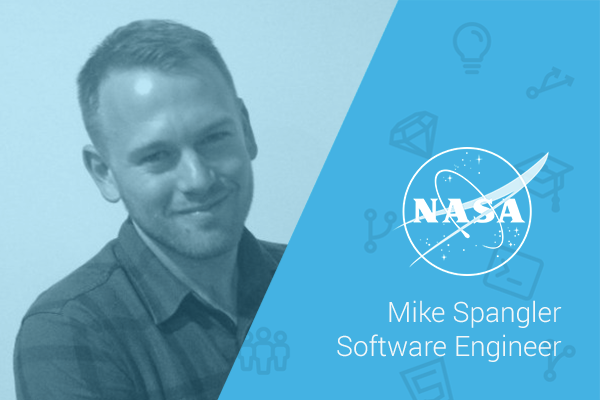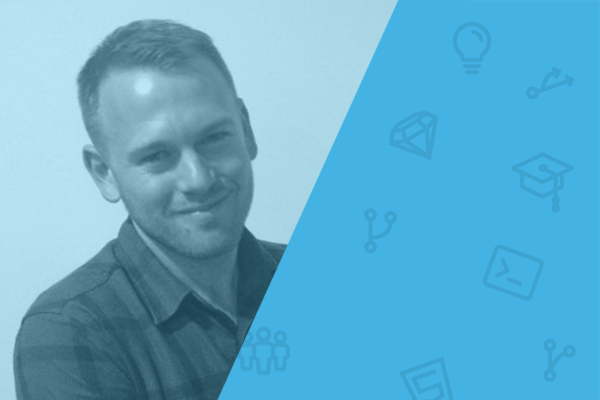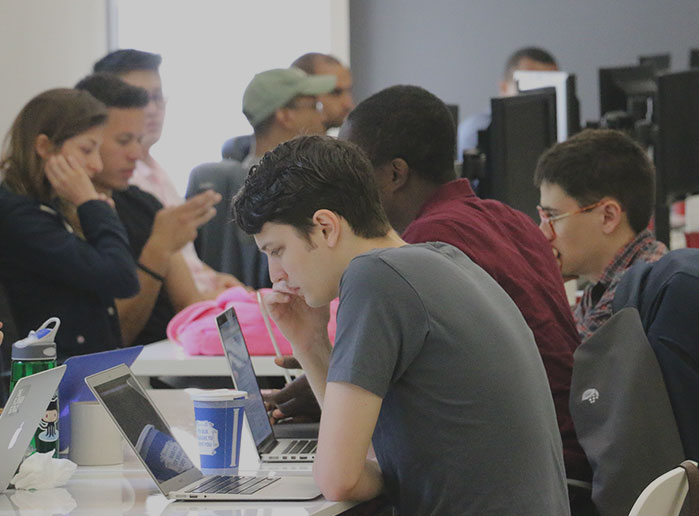In our Beyond the Bootcamp series, we chat with members of our alumni community about their career journeys. What new roles have they taken on since graduating from Flatiron School? How did they get to where they are now? What advice do they have for new programmers following in their footsteps?
Mike Spangler has had quite a unique career journey: after working in film and television, he’s now a software engineer at NASA’s Jet Propulsion Laboratory. (Yes, that NASA.) Read on to see how he learned to code and found a dream job that had previously felt out of reach.

Learning to code
Mike learned to code because he was seeking greater opportunity in his career. “I had an okay career,” Mike says of his work doing logistics and locations in the Film/Television industry. “I was sort of happy, but I wanted to be really happy.” Seeing how quickly the tech field was expanding, Mike realized learning to code could expand his horizons and “raise the ceiling on what was possible in my career.”
The Flatiron School Experience
Flatiron School caught Mike’s attention after he saw a video of Dean Avi Flombaum produced by the Bindery, a production company Mike worked for. “I decided to attend Flatiron school because I just loved Avi’s message of how coding was available to anybody who wanted to put in the effort and considered themselves creative and thoughtful – that it’s not just for math majors,” Mike says. “It’s something that can be learned by anyone.”
For Mike, what really made the experience of attending Flatiron School was being surrounded by incredible peers. “Everyone in my class, almost without exception, dedicated their life entirely to the immersive,” he explains. “They threw themselves in and almost none of them knew anything about coding. There was just this great sense of we’re in it together. This is hard and that’s okay. We’re going to teach each other. We’re going to build each other up, and we’re going to learn this thing. We’re going to change our careers and that’s going to allow us to change our lives. I think Flatiron really offers a sense of community. You have a social and personal stake in your own learning that goes beyond textbook. You want to do it for yourself and you want to do it for your classmates, too.”
The most important thing he learned at Flatiron School was how to be a lifelong learner. “I really keep that in my mind every day – being an open minded lifelong learner,” he says. “Because programming languages come and go, frameworks come and go, development methods like Agile, Scrum, whatever, those can all come and go. The one constant is your openness and ability to take on new information and use that to tackle the problem at hand. Flatiron did an amazing job of making that first principal of being a lifelong learner the most important first step to being a successful programmer for your whole career.”
Life at NASA
Working for NASA had always been on Mike’s career wish list, but working in film and television, Mike says, “I never would have thought that that was somewhere I was going to be able to work or had any idea how I could work there in any capacity.” Nevertheless, after moving to Los Angeles, he saw a job posting and submitted his resume and cover letter “like anywhere else, and just, you know, things happened.”
Mike works on the search team at NASA’s Jet Propulsion Laboratory. There are currently over 30 active missions; several of them are in flight on other planets or around other planets, including Juno at Jupiter, and the Curiosity Rover on Mars. Where does Mike come in? As he explains, “All of these missions generate a tremendous amount of data, whether it’s project schematics or telemetry data, or even something as mundane as personnel details and records. What my job, as part of the search team is, is to parse through that data, make it searchable for our scientists and administrators to find and make actionable decisions on.”

The Spirit Rover on Mars
At NASA, Mike is surrounded by very well-educated colleagues – ”bachelors, masters, PhDs in computer science, aeronautical engineering.” Coming from a coding bootcamp, there’s a lot of opportunity for impostor syndrome to take hold. But for Mike, what really surprised him was how “it doesn’t matter if you’ve had 12 years of schooling or 12 weeks of bootcamp, you’re still going to be on Stack Overflow a fair amount of times throughout the day. I guess I was surprised and relieved to learn that everyone is always learning and always figuring this stuff out. It’s in some ways just as powerful to have the education that I got as the education of someone who went to a long degree program got.”
What’s next for Mike?
Mike could see himself exploring product management in the future. “There are a lot of diverse stakeholders and a lot of different individuals giving input on what products should look like and what features it should have,” he says. “I think it’s a very interesting role to wade through these disparate opinions and figure out what are the critical functionalities and elements that an application should have.”
Ready to start your own programming journey? The best way to get started is our free Bootcamp Prep course. Stay tuned for more installments of “Beyond the Bootcamp”!
Written byJOSH HIRSHFELD
Content Marketing Manager, Flatiron School

